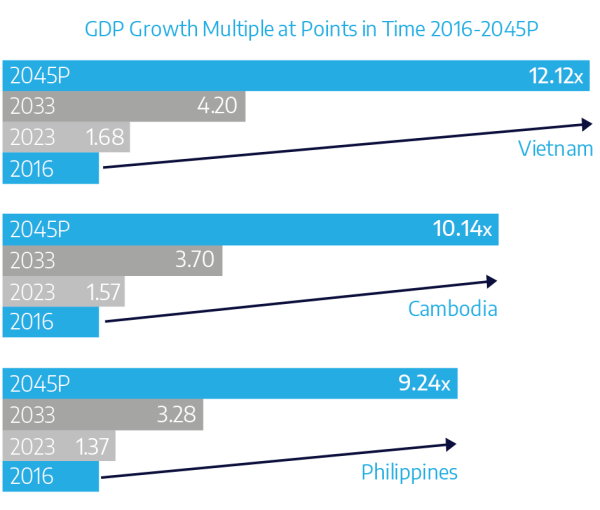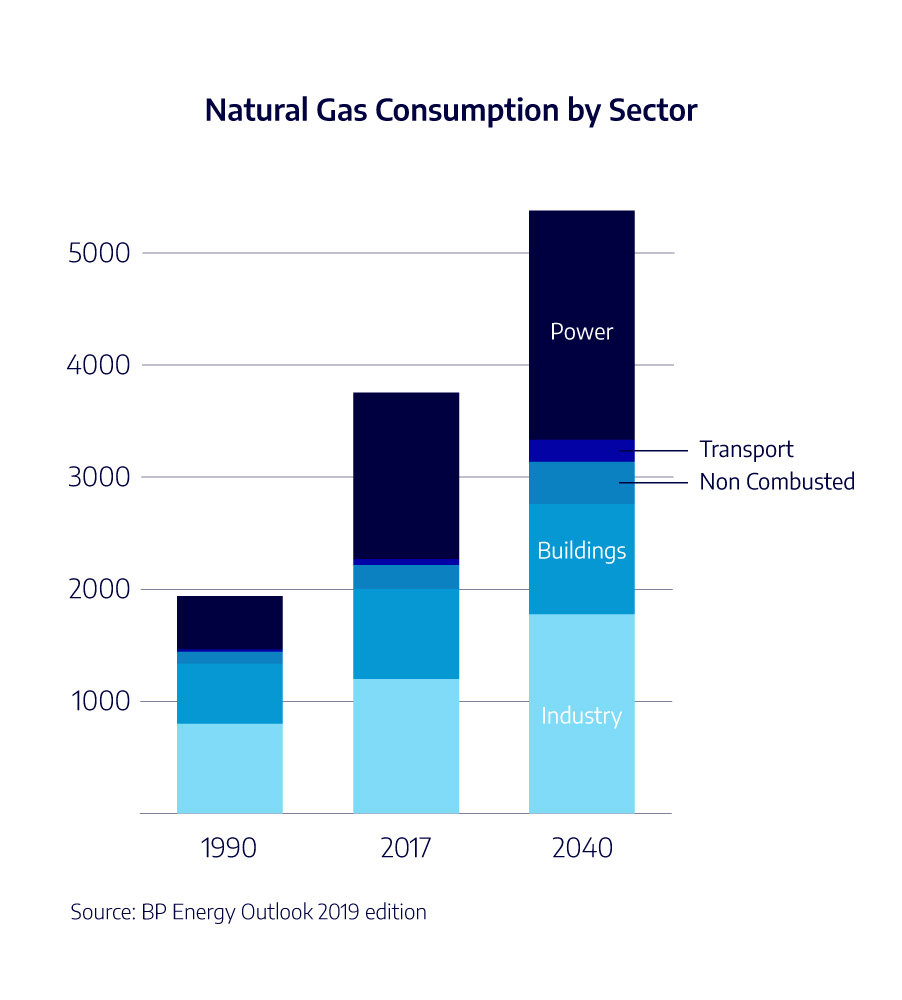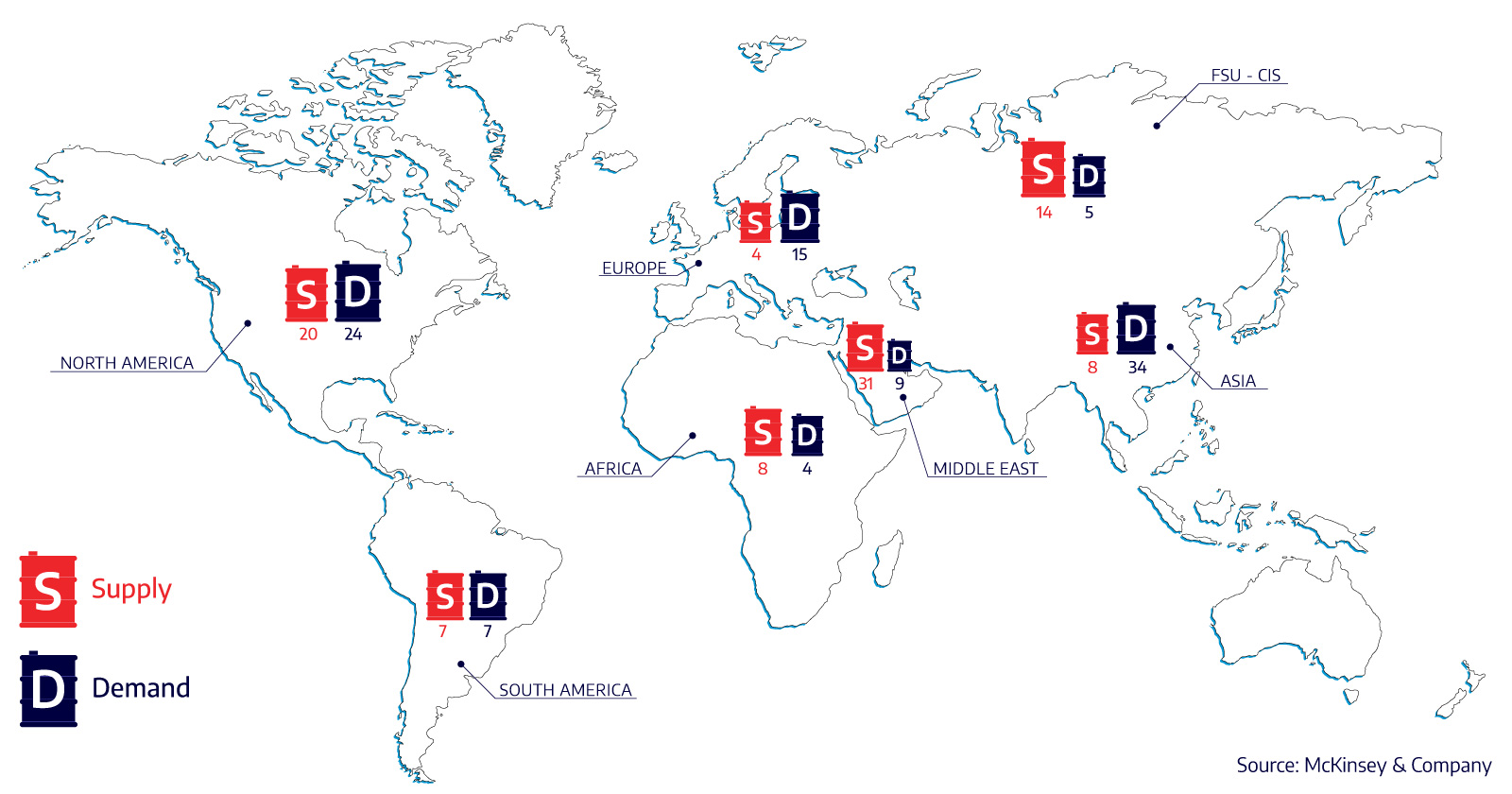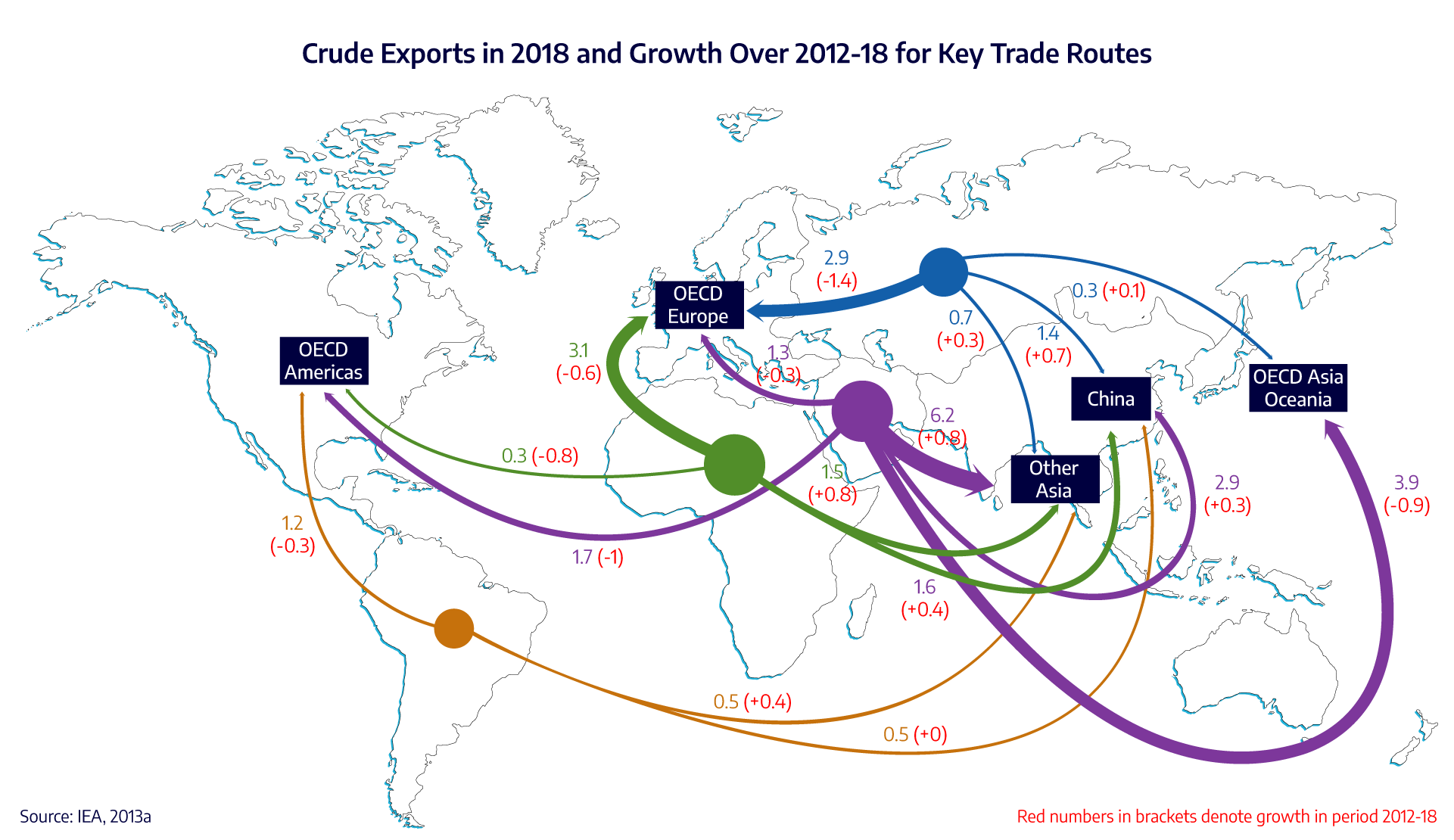Base Case for Growth: Steadily climbing GDP ranks with booming middle-class typify Indochina and other SE Asia Markets

Vietnam’s GDP averaged 6.0% growth from 2016 – 2022, and that includes two-years of COVID in 2020 and 2021.
Cambodia’s GDP grew at 5.2% in 2022 and is forecasted to grow at 5.3% in 2023 and 6.0% in 2024.
The Philippine's GDP grew at 7.6% in 2022 and 5.5% in 2023 and is predicted to grow at 6.0% in 2024.

Vietnam is predicted to make the highest climb up in global GDP by 2050, up 12 places to 20th in the world, with Cambodia rising as it modernizes rapidly with a young population.
The Philippine's is also climbing in the GDP ranks and is expected to be up to 19th place by 2050.

Vietnam has a young population with over 93 million people in total - 60% at working age. Cambodia’s demographics are similar, and that is an additional 17 million consumers.

The rapid expansion of the Vietnamese and Cambodian economies has driven a surging demand for energy which is projected to grow at >10% annually.

According to the Cambodian Ministry of Public Works and Transport, the number of vehicles in 2020 to 2023 has increased rapidly.
From this growth in the number of vehicles, there is a lot of potential for CNRS to provide petroleum products for the country as the number of automotives is expected to increase.
The Ministry also added that the number of vehicles is expected to increase every year, based on the increase in the standard of living of individuals in Cambodia.


Source: ADB: Asian Development Outlook 2024; GDP Data 2016 - 2033 supplied by BMI Fitch Solutions, Inc.
Analysis for GDP projection to 2045 provided by Baron Point Energy Group and KPMG; Cambodia Petroleum Master Plan 2022-2040; ERIA Research Project Report 2021, Cambodian Ministry of Public Works and Transport data and facts used in other areas.
Vietnam refined petroleum product consumption 2016 – 2025F

Primary world energy consumption by fuel is going up
The International Energy Agency ("IEA") in France, in its World Energy Outlook 2024 study revealed that global oil demand could vary from 101 million barrels per day ("mb/d") to 103 mb/d by 2030, and that demand in 2023 surpassed the previous peak set in 2019, increasing by nearly 2 mb/d from 2022 levels to reach 99 mb/d.
This increase was nearly double the average annual increase between 2010 and 2019.
According to the bp Energy Outlook 2023 edition, oil consumption’s new momentum is stronger than expected, remaining close to 100 Mb/d through much of the next 10-years. Also, bullish for energy, emerging economies’ share of global oil demand should increase from 55% in 2021 to approximately 70% in 2050.
Note that the relationship Southeast Asians have with oil is far more positive than activists in the West. People are more supportive of oil companies. These are some of the largest companies in their nations, and National Oil Company success is a source of national pride and a better standard of living, aspirations our team supports.

Natural Gas Consumption by Sector
According to the bp Energy Outlook 2024 Edition, natural gas consumption is rising in emerging economies as they grow and industrialize. Strong growth in natural gas demand in emerging Asian economies has increased the importance of liquified natural gas (LNG) within global gas markets.

Additional Mega-trends that support growth and the Base Case for Indochina
World Population Growth Drives World Demand for Energy which Continues to Rise Steadily
- By 2050, there should be approximately 9.7 billion people in the world, a twenty-plus percent increase from 2023
According to Max Roser, a University of Oxford research fellow in economics, 200 years ago there were less than one billion humans living on earth. Today, according to United Nations calculations, the global human population reached 8.0 billion in mid-November 2022. This makes the world’s population more than three times larger than it was in the mid-twentieth century.
To contrast:
- The world had an estimated 2.5 billion people in 1950, compared to 8 billion people today;
- We have added 1 billion people since 2010 and 2 billion since 1998;
- The world’s population is expected to increase by nearly 2 billion persons in the next 30 years, roughly the same amount as it increased in the past thirty years; and
- The world’s population may not peak until the mid-2080s to 2100, in the 10.4 to 11.2 billion range.

World Income Distribution in 1800, 1975, and 2015
- By the end of the century, demand for energy will have tripled under the combined pressure of world population growth, increased urbanization and expanding access to electricity as life according to the international poverty line continues to improve
In 1800, much of the world lived in poverty, but by 2015 the world became richer and a less unequal place to live, creating more energy consumers and demand.

World Oil Production & Demand
- The share of global oil demand should increase from 55% in 2021 to approximately 70% in 2050 in emerging economies.
The long-term influence of better economic conditions around the world, technological advancement and the knock-on effect of higher living standards creates rising demand for energy, particularly in the Far East where emerging economies are growing fast.
According to the Bunker Fuel Market Report 2024, the market size has grown strongly in recent years. It will grow from US$ 143.36 billion in 2023 to US$ 150.93 billion in 2024 at a compound annual growth rate (“CAGR”) of 5.3%, and it is expected to grow to US$ 186.28 billion by 2028 at a CAGR of 5.4%. The growth during this historic period can be attributed to heightened awareness and pressure to reduce greenhouse gas emissions, the modernization of ships, the introduction of new, more fuel-efficient vessels, the increased utilization of larger ships, the shift toward ultra-large container vessels, and changes in the composition and age of the global shipping fleet.
It would seem the growth in population, emerging markets living standards equalization, and modernization with a goal to reduce greenhouse gas emission is driving more demand for energy.

Go Far East, Young Man, Go Far East!
- Population growth, economic stability, and rise in income all contribute to a significant increase in demand for gasoline and diesel, especially in Vietnam and Cambodia.
As of 2023, more than 20 mb/d of oil passes through the Strait of Hormuz and a further 7.5 mb/d of oil passes through the Suez Canal. 75% of this oil is going to Asia.
According to Wood Mackenzie, in Vietnam, over the next ten years, gasoline consumption should increase by an annual growth rate of 4.9% — BMI Research, a FitchGroup Company, maintains a similar 4.7% growth rate.
Demand for gasoline and diesel in Cambodia amounts to 23% and 53% of total demand, the greatest of any fuel consumed by the Cambodians. The market share of gasoline is increasing in line with economic development, with an estimated GDP by the World Bank of 6.3% in 2025. As the population grows, and the standard of living equalizes, gasoline is being used for the primary mode of transport, e.g. motorbikes, new cars and SUVs. Logistics in the country such as heavy trucking and agriculture is heavily reliant on diesel products. Therefore, fuel consumption is projected to grow at 5.6% CAGR between 2025 to 2040, according to the Royal Government of Cambodia (Cambodia Petroleum Master Plan 2022 – 2040 General Department of Petroleum).
Regarding EV displacement, according to research conducted by KPMG Cambodia Ltd, the country has a low level of ability, both technologically and financially, to facilitate the transition away from gasoline and diesel. The government has limited plans for transitioning the mass market to EV or alternative fuel sources for vehicles, and while EVs continue to grow in popularity, the charging network remains unfeasibly limited. This will undoubtedly improve in urban areas over the next 50 years, but national transformation remains a remote prospect and Cambodia’s fuel consumption is project to grow over the next 25 years, rather than retract.





 Traded professionally for over 10 years at Trafigura (Trading Manager), Socar (Senior Trader), and Total (Gasoline Trader).
Traded professionally for over 10 years at Trafigura (Trading Manager), Socar (Senior Trader), and Total (Gasoline Trader). Emphasizing the Oil & Gas industry for Fund investment allocations since stationing in Abu Dhabi, UAE in 2015 at the behest of a member of the Royal Family of Abu Dhabi.
Emphasizing the Oil & Gas industry for Fund investment allocations since stationing in Abu Dhabi, UAE in 2015 at the behest of a member of the Royal Family of Abu Dhabi.